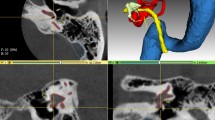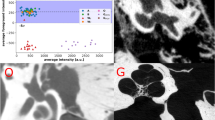Abstract
Purpose
Imaging diagnosis of stapes fixation (SF) is challenging owing to a lack of definite evidence. We developed a comprehensive machine learning (ML) model to identify SF on ultra-high-resolution CT.
Materials and methods
We retrospectively enrolled 109 participants (143 ears) and divided them into the training set (115 ears) and test set (28 ears). Stapes mobility (SF or non-SF) was determined by surgical inspection. In the ML analysis, rectangular regions of interest were placed on consecutive axial slices in the training set. Radiomic features were extracted and fed into the training session. The test set was analyzed using 7 ML models (support vector machine, k nearest neighbor, decision tree, random forest, extra trees, eXtreme Gradient Boosting, and Light Gradient Boosting Machine) and by 2 dedicated neuroradiologists. Diagnostic performance (sensitivity, specificity and accuracy, with surgical findings as the reference) was compared between the radiologists and the optimal ML model by using the McNemar test.
Results
The mean age of the participants was 42.3 ± 17.5 years. The Light Gradient Boosting Machine (LightGBM) model showed the highest sensitivity (0.83), specificity (0.81), accuracy (0.82) and area under the curve (0.88) for detecting SF among the 7 ML models. The neuroradiologists achieved good sensitivities (0.75 and 0.67), moderate-to-good specificities (0.63 and 0.56) and good accuracies (0.68 and 0.61). This model showed no statistical differences with the neuroradiologists (P values 0.289–1.000).
Conclusions
Compared to the neuroradiologists, the LightGBM model achieved competitive diagnostic performance in identifying SF, and has the potential to be a supportive tool in clinical practice.





Similar content being viewed by others
Abbreviations
- SF:
-
Stapes fixation
- AI:
-
Artificial intelligence
- U-HRCT:
-
Ultra-high-resolution CT
- ML:
-
Machine learning
- ROI:
-
Region of interest
- LASSO:
-
Least Absolute Shrinkage and Selection Operator
- PPV:
-
Positive predictive value
- NPV:
-
Negative predictive value
- ROC:
-
Receiver operating characteristic
- AUC:
-
Area under the curve
- CI:
-
Confidence interval
References
Nakajima HH, Ravicz ME, Merchant SN, Peake WT, Rosowski JJ. Experimental ossicular fixations and the middle ear’s response to sound: evidence for a flexible ossicular chain. Hear Res. 2005;204(1–2):60–77.
Shin YJ, Fraysse B, Deguine O, Cognard C, Charlet JP, Sevely A. Sensorineural hearing loss and otosclerosis: a clinical and radiologic survey of 437 cases. Acta Otolaryngol. 2001;121(2):200–4.
Karosi T, Csomor P, Petko M, Liktor B, Szabo LZ, Pytel J, et al. Histopathology of nonotosclerotic stapes fixations. Otol Neurotol. 2009;30(8):1058–66.
Park K, Choung YH. Isolated congenital ossicular anomalies. Acta Otolaryngol. 2009;129(4):419–22.
Karosi T, Csomor P, Sziklai I. The value of HRCT in stapes fixations corresponding to hearing thresholds and histologic findings. Otol Neurotol. 2012;33(8):1300–7.
Guild SR. Histologic otosclerosis. Ann Otol Rhinol Laryngol. 1944;53:246–67.
Altmann F, Glasgold A, Macduff JP. The incidence of otosclerosis as related to race and sex. Ann Otol Rhinol Laryngol. 1967;76(2):377–92.
Totten DJ, Marinelli JP, Carlson ML. Incidence of congenital stapes footplate fixation since 1970: a population-based study. Otol Neurotol. 2020;41(4):489–93.
Akazawa Y, Ganaha A, Higa T, Kondo S, Oyakawa Y, Hirakawa H, et al. Measurement of stapes footplate thickness in otosclerosis by ultra-high-resolution computed tomography. Acta Otolaryngol. 2020;140(11):899–903.
Dinc AE, Kumbul YC. Clinical landmarks in chronic otitis media with tympanosclerosis: clinical history may have predictive value in the diagnosis of ossicular chain mobility. J Laryngol Otol. 2019;133(11):992–4.
Boleas-Aguirre MS, Ruiz de Erenchun-Lasa I, Bulnes-Plano MD. Audiological results after total ossicular reconstruction for stapes fixation. Eur Arch Otorhinolaryngol. 2015;272(11):3123–30.
Wycherly BJ, Berkowitz F, Noone AM, Kim HJ. Computed tomography and otosclerosis: a practical method to correlate the sites affected to hearing loss. Ann Otol Rhinol Laryngol. 2010;119(12):789–94.
Vincent R, Oates J, Sperling NM. Stapedotomy for tympanosclerotic stapes fixation: is it safe and efficient? a review of 68 cases. Otol Neurotol. 2002;23(6):866–72.
Acar GO, Kivekas I, Hanna BM, Huang L, Gopen Q, Poe DS. Comparison of stapedotomy minus prosthesis, circumferential stapes mobilization, and small fenestra stapedotomy for stapes fixation. Otol Neurotol. 2014;35(4):e123–9.
Dalchow CV, Dunne AA, Sesterhenn A, Teymoortash A, Werner JA. Malleostapedotomy: the marburg experience. Adv Otorhinolaryngol. 2007;65:215–21.
Nassiri AM, Benson JC, Doerfer KW, Perkins EL, Sweeney AD, Patel NS, et al. Absent pyramidal eminence and stapedial tendon associated with congenital stapes footplate fixation: intraoperative and radiographic findings. Am J Otolaryngol. 2021;42(6): 103144.
Brown LA, Mocan BO, Redleaf MI. Diagnostic protocol for detecting otosclerosis on high-resolution temporal bone CT. Ann Otol Rhinol Laryngol. 2019;128(11):1054–60.
Priya SR, Singh PP, Upreti L, Vaid L. High resolution computed tomography in stapedial otosclerosis. Indian J Otolaryngol Head Neck Surg. 2013;65(Suppl 3):505–11.
Tringali S, Pouget JF, Bertholon P, Dubreuil C, Martin C. Value of temporal bone density measurements in otosclerosis patients with normal-appearing computed tomographic scan. Ann Otol Rhinol Laryngol. 2007;116(3):195–8.
Bi WL, Hosny A, Schabath MB, Giger ML, Birkbak NJ, Mehrtash A, et al. Artificial intelligence in cancer imaging: clinical challenges and applications. CA Cancer J Clin. 2019;69(2):127–57.
Geras KJ, Mann RM, Moy L. Artificial intelligence for mammography and digital breast tomosynthesis: current concepts and future perspectives. Radiology. 2019;293(2):246–59.
Choi YS, Bae S, Chang JH, Kang SG, Kim SH, Kim J, et al. Fully automated hybrid approach to predict the IDH mutation status of gliomas via deep learning and radiomics. Neuro Oncol. 2021;23(2):304–13.
Rudie JD, Rauschecker AM, Bryan RN, Davatzikos C, Mohan S. Emerging applications of artificial intelligence in neuro-oncology. Radiology. 2019;290(3):607–18.
Castellano G, Bonilha L, Li LM, Cendes F. Texture analysis of medical images. Clin Radiol. 2004;59(12):1061–9.
van Timmeren JE, Cester D, Tanadini-Lang S, Alkadhi H, Baessler B. Radiomics in medical imaging-“how-to” guide and critical reflection. Insights Imaging. 2020;11(1):91.
Arbelaez Ossa L, Starke G, Lorenzini G, Vogt JE, Shaw DM, Elger BS. Re-focusing explainability in medicine. Digit Health. 2022;8:20552076221074490.
Lekadir K, Osuala R, Gallin C, Lazrak N, Kushibar K, Tsakou G, et al. FUTURE-AI: Guiding principles and consensus recommendations for trustworthy artificial intelligence in medical imaging. arXiv preprint arXiv:210909658. 2021.
Tang R, Yin H, Wang Z, Zhang Z, Zhao L, Zhang P, et al. Stapes visualization by ultra-high resolution CT in cadaveric heads: a preliminary study. Eur J Radiol. 2021;141: 109786.
Heutink F, Klabbers TM, Huinck WJ, Lucev F, van der Woude WJ, Mylanus EAM, et al. Ultra-high-resolution CT to detect intracochlear new bone formation after cochlear implantation. Radiology. 2022;302(3):605–12.
Fujiwara M, Watanabe Y, Kashiwagi N, Ohta Y, Sato T, Nishigaki M, et al. Improved visualization of the chorda tympani nerve using ultra-high-resolution computed tomography. Acta Radiol Open. 2021;10(11):20584601211061444.
Yamashita K, Hiwatashi A, Togao O, Kikuchi K, Matsumoto N, Momosaka D, et al. Ultrahigh-resolution CT scan of the temporal bone. Eur Arch Otorhinolaryngol. 2018;275(11):2797–803.
Heutink F, Koch V, Verbist B, van der Woude WJ, Mylanus E, Huinck W, et al. Multi-scale deep learning framework for cochlea localization, segmentation and analysis on clinical ultra-high-resolution CT images. Comput Methods Programs Biomed. 2020;191: 105387.
Depeursinge A, Chin AS, Leung AN, Terrone D, Bristow M, Rosen G, et al. Automated classification of usual interstitial pneumonia using regional volumetric texture analysis in high-resolution computed tomography. Invest Radiol. 2015;50(4):261–7.
Fujima N, Andreu-Arasa VC, Onoue K, Weber PC, Hubbell RD, Setty BN, et al. Utility of deep learning for the diagnosis of otosclerosis on temporal bone CT. Eur Radiol. 2021;31(7):5206–11.
Acknowledgements
This study has received funding by National Natural Science Foundation of China (61931013, 82171886), Beijing Natural Science Foundation (7222301), Capital’s Funds for Health Improvement and Research (No. 2022-1-1111), Beijing Scholar 2015 (No. [2015] 160), and Beijing Key Clinical Discipline Funding (No. 2021-135).
Funding
National Natural Science Foundation of China, 61931013, Zhenchang Wang, 82171886, Pengfei Zhao, Beijing Natural Science Foundation, 7222301, Pengfei Zhao, Capital’s Funds for Health Improvement and Research, 2022-1-1111, Zhenchang Wang, Beijing Scholar 2015, [2015] 160, Zhenchang Wang, Beijing Key Clinical Discipline Funding, 2021-135, Zhenchang Wang.
Author information
Authors and Affiliations
Contributions
Conceptualization: RT, JL, PZ, HD; methodology: RT, JL, PZ, ZW; formal analysis and investigation: RT, JL, ZZ, HY, NX; writing—original draft preparation: RT, JL; writing—review and editing: RT, JL, PZ, ZZ, HY, HD, NX, ZY, ZW; funding acquisition: ZW; resources: PZ, ZY, ZW; supervision: PZ, ZY, ZW.
Corresponding authors
Ethics declarations
Conflict of interest
The authors declare that they have no conflict of interest.
Ethical approval
All procedures performed in studies involving human participants were in accordance with the ethical standards of the institutional and/or national research committee and with the 1964 Helsinki Declaration and its later amendments or comparable ethical standards.
Consent to participate
Informed consent was waived from all individual participants included in the study.
Additional information
Publisher's Note
Springer Nature remains neutral with regard to jurisdictional claims in published maps and institutional affiliations.
Ruowei Tang and Jia Li are co-first authors.
Supplementary Information
Below is the link to the electronic supplementary material.
About this article
Cite this article
Tang, R., Li, J., Zhao, P. et al. Utility of machine learning for identifying stapes fixation on ultra-high-resolution CT. Jpn J Radiol 42, 69–77 (2024). https://doi.org/10.1007/s11604-023-01475-2
Received:
Accepted:
Published:
Issue Date:
DOI: https://doi.org/10.1007/s11604-023-01475-2




